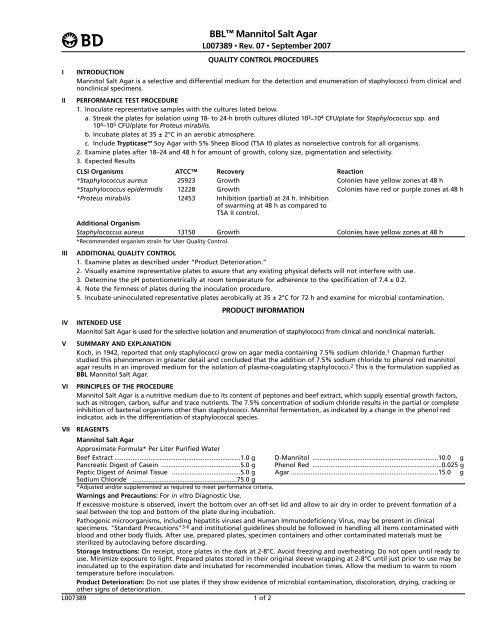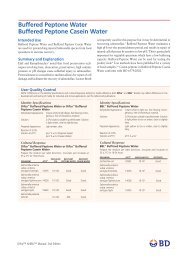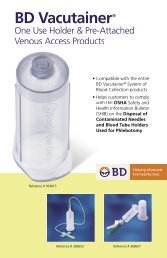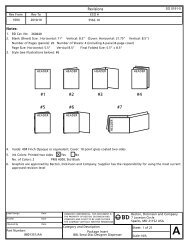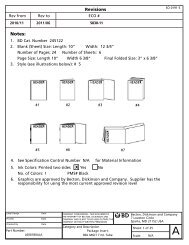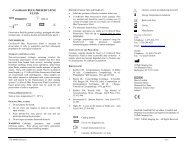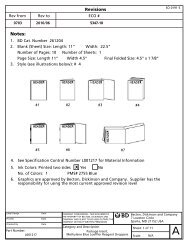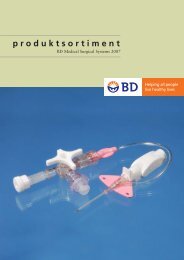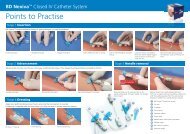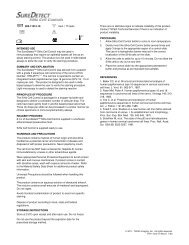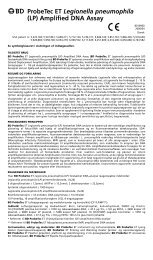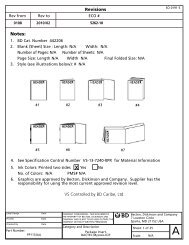BBL™ Mannitol Salt Agar - BD
BBL™ Mannitol Salt Agar - BD
BBL™ Mannitol Salt Agar - BD
Create successful ePaper yourself
Turn your PDF publications into a flip-book with our unique Google optimized e-Paper software.
BBL <strong>Mannitol</strong> <strong>Salt</strong> <strong>Agar</strong><br />
L007389 • Rev. 07 • September 2007<br />
QUALITY CONTROL PROCEDURES<br />
I INTRODUCTION<br />
<strong>Mannitol</strong> <strong>Salt</strong> <strong>Agar</strong> is a selective and differential medium for the detection and enumeration of staphylococci from clinical and<br />
nonclinical specimens.<br />
II PERFORMANCE TEST PROCEDURE<br />
1. Inoculate representative samples with the cultures listed below.<br />
a. Streak the plates for isolation using 18- to 24-h broth cultures diluted 103 –104 CFU/plate for Staphylococcus spp. and<br />
104 –105 CFU/plate for Proteus mirabilis.<br />
b. Incubate plates at 35 ± 2°C in an aerobic atmosphere.<br />
c. Include Trypticase Soy <strong>Agar</strong> with 5% Sheep Blood (TSA II) plates as nonselective controls for all organisms.<br />
2. Examine plates after 18–24 and 48 h for amount of growth, colony size, pigmentation and selectivity.<br />
3. Expected Results<br />
CLSI Organisms ATCC Recovery Reaction<br />
*Staphylococcus aureus 25923 Growth Colonies have yellow zones at 48 h<br />
*Staphylococcus epidermidis 12228 Growth Colonies have red or purple zones at 48 h<br />
*Proteus mirabilis<br />
Additional Organism<br />
12453 Inhibition (partial) at 24 h. Inhibition<br />
of swarming at 48 h as compared to<br />
TSA II control.<br />
Staphylococcus aureus 13150 Growth Colonies have yellow zones at 48 h<br />
*Recommended organism strain for User Quality Control.<br />
III ADDITIONAL QUALITY CONTROL<br />
1. Examine plates as described under “Product Deterioration.”<br />
2. Visually examine representative plates to assure that any existing physical defects will not interfere with use.<br />
3. Determine the pH potentiometrically at room temperature for adherence to the specification of 7.4 ± 0.2.<br />
4. Note the firmness of plates during the inoculation procedure.<br />
5. Incubate uninoculated representative plates aerobically at 35 ± 2°C for 72 h and examine for microbial contamination.<br />
PRODUCT INFORMATION<br />
IV INTENDED USE<br />
<strong>Mannitol</strong> <strong>Salt</strong> <strong>Agar</strong> is used for the selective isolation and enumeration of staphylococci from clinical and nonclinical materials.<br />
V SUMMARY AND EXPLANATION<br />
Koch, in 1942, reported that only staphylococci grow on agar media containing 7.5% sodium chloride. 1 Chapman further<br />
studied this phenomenon in greater detail and concluded that the addition of 7.5% sodium chloride to phenol red mannitol<br />
agar results in an improved medium for the isolation of plasma-coagulating staphylococci. 2 This is the formulation supplied as<br />
BBL <strong>Mannitol</strong> <strong>Salt</strong> <strong>Agar</strong>.<br />
VI PRINCIPLES OF THE PROCEDURE<br />
<strong>Mannitol</strong> <strong>Salt</strong> <strong>Agar</strong> is a nutritive medium due to its content of peptones and beef extract, which supply essential growth factors,<br />
such as nitrogen, carbon, sulfur and trace nutrients. The 7.5% concentration of sodium chloride results in the partial or complete<br />
inhibition of bacterial organisms other than staphylococci. <strong>Mannitol</strong> fermentation, as indicated by a change in the phenol red<br />
indicator, aids in the differentiation of staphylococcal species.<br />
VII REAGENTS<br />
<strong>Mannitol</strong> <strong>Salt</strong> <strong>Agar</strong><br />
Approximate Formula* Per Liter Purified Water<br />
Beef Extract ......................................................................1.0 g D-<strong>Mannitol</strong> ......................................................................10.0 g<br />
Pancreatic Digest of Casein ............................................5.0 g Phenol Red ........................................................................0.025 g<br />
Peptic Digest of Animal Tissue ......................................5.0 g<br />
Sodium Chloride ..........................................................75.0 g<br />
*Adjusted and/or supplemented as required to meet performance criteria.<br />
Warnings and Precautions: For in vitro Diagnostic Use.<br />
<strong>Agar</strong> ..................................................................................15.0 g<br />
If excessive moisture is observed, invert the bottom over an off-set lid and allow to air dry in order to prevent formation of a<br />
seal between the top and bottom of the plate during incubation.<br />
Pathogenic microorganisms, including hepatitis viruses and Human Immunodeficiency Virus, may be present in clinical<br />
specimens. "Standard Precautions" 3-6 and institutional guidelines should be followed in handling all items contaminated with<br />
blood and other body fluids. After use, prepared plates, specimen containers and other contaminated materials must be<br />
sterilized by autoclaving before discarding.<br />
Storage Instructions: On receipt, store plates in the dark at 2-8°C. Avoid freezing and overheating. Do not open until ready to<br />
use. Minimize exposure to light. Prepared plates stored in their original sleeve wrapping at 2-8°C until just prior to use may be<br />
inoculated up to the expiration date and incubated for recommended incubation times. Allow the medium to warm to room<br />
temperature before inoculation.<br />
Product Deterioration: Do not use plates if they show evidence of microbial contamination, discoloration, drying, cracking or<br />
other signs of deterioration.<br />
L007389 1 of 2
VIII SPECIMEN COLLECTION AND HANDLING<br />
Specimens suitable for culture may be handled using various techniques. For detailed information, consult appropriate texts. 7,8<br />
Specimens should be obtained before antimicrobial therapy has been administered. Provision must be made for prompt<br />
delivery to the laboratory.<br />
IX PROCEDURE<br />
Material Provided: <strong>Mannitol</strong> <strong>Salt</strong> <strong>Agar</strong><br />
Materials Required But Not Provided: Ancillary culture media, reagents, quality control organisms and laboratory equipment as<br />
required.<br />
Test Procedure: Observe aseptic techniques.<br />
The agar surface should be smooth and moist, but without excessive moisture.<br />
Streak the specimen as soon as possible after it is received in the laboratory. The streak plate is used primarily to isolate pure<br />
cultures from specimens containing mixed flora. Alternatively, if material is being cultured directly from a swab, roll the swab<br />
over a small area of the surface at the edge and streak from this inoculated area.<br />
Incubate plates 24–48 h at 35 ± 2°C in an aerobic atmosphere.<br />
User Quality Control: See “Quality Control Procedures.”<br />
Quality Control requirements must be performed in accordance with applicable local, state and/or federal regulations or<br />
accreditation requirements and your laboratory’s standard Quality Control procedures. It is recommended that the user refer to<br />
pertinent CLSI (formerly NCCLS) guidance and CLIA regulations for appropriate Quality Control practices.<br />
X RESULTS<br />
After incubation most plates will show an area of confluent growth. Because the streaking procedure is, in effect, a "dilution"<br />
technique, diminishing numbers of microorganisms are deposited on the streaked areas. Consequently, one or more of these<br />
areas should exhibit isolated colonies of the organisms contained in the specimen. Further, growth of each organism may be<br />
semi-quantitatively scored on the basis of growth in each of the streaked areas. Better isolation is obtained due to the<br />
inhibitory action of the medium.<br />
Typical colonial morphology on <strong>Mannitol</strong> <strong>Salt</strong> <strong>Agar</strong> is as follows:<br />
Staphylococcus aureus ..................Small to large with yellow zones Streptococci............................No growth to trace growth<br />
Staphylococci other Micrococci ..............................Large, white to orange<br />
than S. aureus ................................Small to large with red zones Gram-negative bacteria ........No growth to trace growth<br />
XI LIMITATIONS OF THE PROCEDURE<br />
For identification, organisms must be in pure culture. Morphological, biochemical and/or serological tests should be performed<br />
for final identification. Consult appropriate texts for detailed information and recommended procedures. 7-12<br />
A single medium is rarely adequate for detecting all organisms of potential significance in a specimen. It should be recognized<br />
that organisms generally susceptible to the antimicrobial agent in a selective medium may be completely or only partially<br />
inhibited depending upon the concentration of the agent, the characteristics of the microbial strain and the number of<br />
organisms in the inoculum. Organisms that are generally resistant to the antimicrobial agent should not be inhibited. Cultures<br />
of specimens grown on selective media should, therefore, be compared with specimens cultured on nonselective media to<br />
obtain additional information and help ensure recovery of potential pathogens.<br />
XII AVAILABILITY<br />
Cat. No. Description<br />
221173 BBL <strong>Mannitol</strong> <strong>Salt</strong> <strong>Agar</strong>, Pkg. of 20 plates<br />
221271 BBL <strong>Mannitol</strong> <strong>Salt</strong> <strong>Agar</strong>, Ctn. of 100 plates<br />
XIII REFERENCES<br />
1. Koch, F.E. 1942. Electivnahrboden fur Staphylokok ken. Zentr. Bakt. Parasitenk., I, Orig. 149:122-124.<br />
2. Chapman, G.H. 1945. The significance of sodium chloride in studies of staphylococci. J. Bacteriol. 50:201-203.<br />
3. National Committee for Clinical Laboratory Standards. 2001. Approved Guideline M29-A2. Protection of laboratory workers from<br />
occupationally acquired infections, 2nd ed. NCCLS, Wayne, PA.<br />
4. Garner, J.S. 1996. Hospital Infection Control Practices Advisory Committee, U.S. Department of Health and Human Services, Centers for Disease<br />
Control and Prevention. Guideline for isolation precautions in hospitals. Infect. Control Hospital Epidemiol. 17:53-80.<br />
5. U.S. Department of Health and Human Services. 1999. Biosafety in microbiological and biomedical laboratories, HHS Publication (CDC), 4th<br />
ed. U.S. Government Printing Office, Washington, D.C.<br />
6. Directive 2000/54/EC of the European Parliament and of the Council of 18 September 2000 on the protection of workers from risks related to<br />
exposure to biological agents at work (seventh individual directive within the meaning of Article 16(1) of Directive 89/391/EEC). Official<br />
Journal L262, 17/10/2000, p. 0021-0045.<br />
7. Murray, P.R., E.J. Baron, J.H. Jorgensen, M.A. Pfaller, and R. H. Yolken (ed.). 2003. Manual of clinical microbiology, 8th ed. American Society for<br />
Microbiology, Washington, D.C.<br />
8. Forbes, B.A., D.F. Sahm, and A.S. Weissfeld. 2002. Bailey and Scott's diagnostic microbiology, 11th ed. Mosby, Inc., St. Louis.<br />
9. Holt, J.G., N.R. Krieg, P.H.A. Sneath, J.T. Staley, and S.T. Williams (ed.). 1994. Bergey's Manual of determinative bacteriology, 9th ed. Williams<br />
& Wilkins, Baltimore.<br />
10. MacFaddin, J.F. 2000. Biochemical tests for identification of medical bacteria, 3rd ed. Lippincott Williams & Wilkins, Baltimore.<br />
11. Koneman, E.W., S.D. Allen, W.M. Janda, P.C. Schreckenberger, and W.C. Winn, Jr. 1997. Color atlas and textbook of diagnostic microbiology,<br />
5th ed. Lippincott-Raven, Philadelphia.<br />
12. Isenberg, H.D. (ed.). 2004. Clinical microbiology procedures handbook, vol. 1, 2 and 3, 2nd ed. American Society for Microbiology, Washington, D.C.<br />
Becton, Dickinson and Company<br />
7 Loveton Circle<br />
Sparks, Maryland 21152 USA<br />
800-638-8663<br />
ATCC is a trademark of the American Type Culture Collection.<br />
<strong>BD</strong>, <strong>BD</strong> Logo, BBL, and Trypticase are trademarks of Becton, Dickinson and Company. ©2007 <strong>BD</strong>.<br />
L007389 2 of 2


